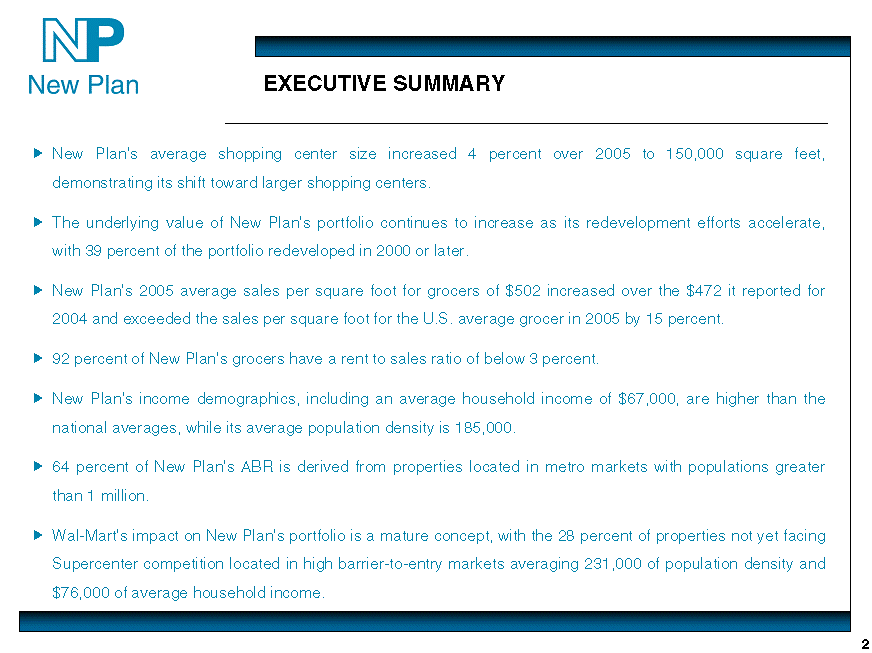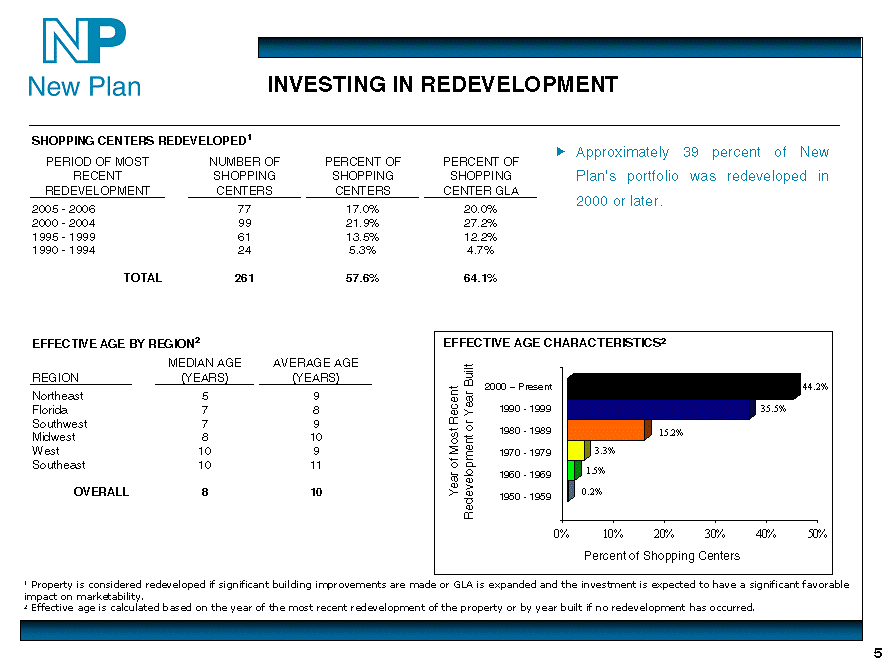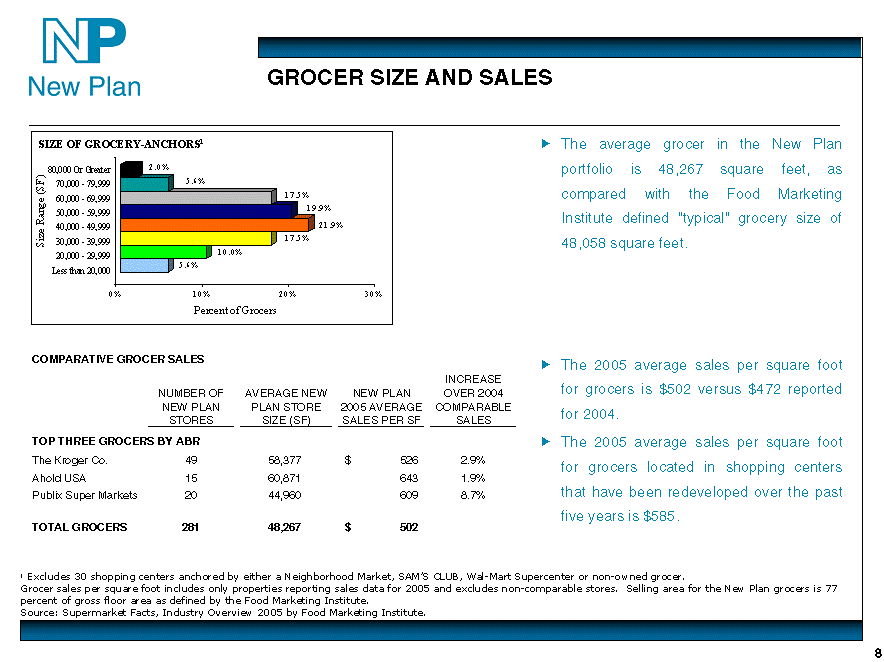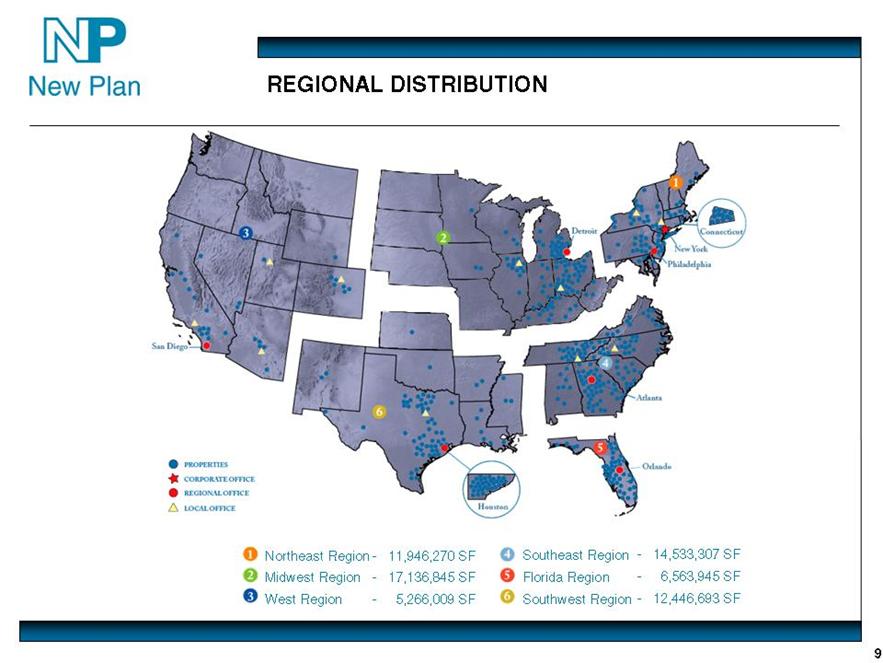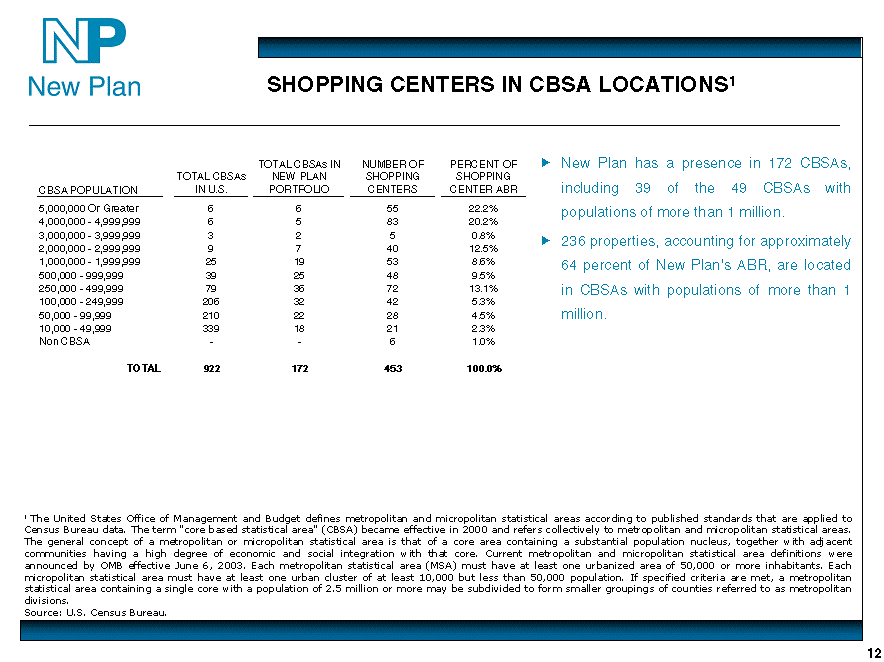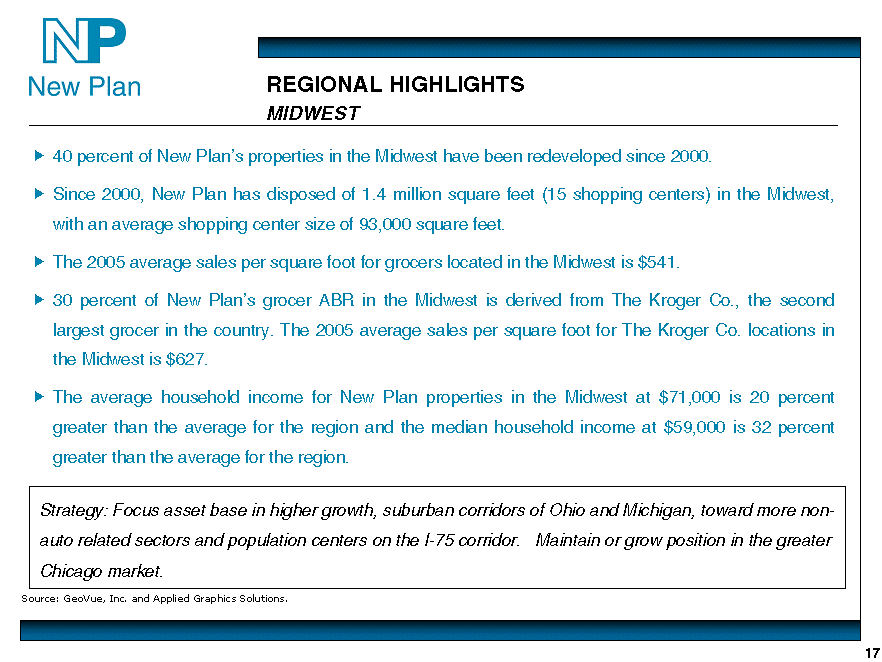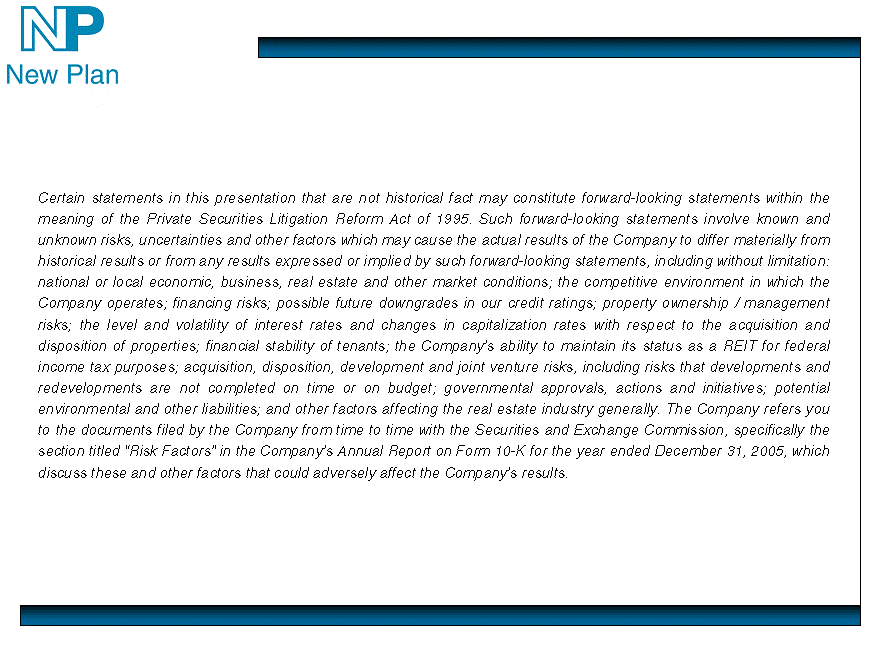Searchable text section of graphics shown above
NP
New Plan
PORTFOLIO ASSESSMENT
Physical Characteristics
and Market Analysis
As of June 30, 2006
EXECUTIVE SUMMARY
• New Plan’s average shopping center size increased 4 percent over 2005 to 150,000 square feet, demonstrating its shift toward larger shopping centers.
• The underlying value of New Plan’s portfolio continues to increase as its redevelopment efforts accelerate, with 39 percent of the portfolio redeveloped in 2000 or later.
• New Plan’s 2005 average sales per square foot for grocers of $502 increased over the $472 it reported for 2004 and exceeded the sales per square foot for the U.S. average grocer in 2005 by 15 percent.
• 92 percent of New Plan’s grocers have a rent to sales ratio of below 3 percent.
• New Plan’s income demographics, including an average household income of $67,000, are higher than the national averages, while its average population density is 185,000.
• 64 percent of New Plan’s ABR is derived from properties located in metro markets with populations greater than 1 million.
• Wal-Mart’s impact on New Plan’s portfolio is a mature concept, with the 28 percent of properties not yet facing Supercenter competition located in high barrier-to-entry markets averaging 231,000 of population density and $76,000 of average household income.
2
PORTFOLIO BREAKDOWN
| | NUMBER OF | | | |
| | PROPERTIES | | GLA (SF) | |
| | | | | |
Community and Neighborhood Shopping Centers | | | | | |
Company Portfolio | | 285 | | 41,183,794 | |
Joint Venture Portfolios | | 172 | | 26,709,275 | |
TOTAL SHOPPING CENTER PORTFOLIO | | 457 | | 67,893,069 | |
| | | | | |
New Development Properties(1) | | | | | |
Company Portfolio | | 5 | | 263,740 | |
Joint Venture Portfolios | | 1 | | 150,944 | |
Miscellaneous Properties | | | | | |
Company Portfolio | | 15 | | 1,113,722 | |
Joint Venture Portfolios | | 2 | | - | |
| | | | | |
TOTAL | | 480 | | 69,421,475 | |
(1)All projects are community and neighborhood shopping centers. Includes expected total GLA.
Portfolio Assessment includes 100 percent of GLA for joint venture portfolios.
Portfolio Assessment includes pro rata share of ABR for joint venture portfolios.
The remainder of the Portfolio Assessment does not include information on new development properties; miscellaneous properties; NPK Redevelopment I, LLC joint venture (three community shopping centers); and Westgate Mall, LLC joint venture (one community shopping center).
3
TYPES OF SHOPPING CENTERS(1)
| | NUMBER OF
SHOPPING
CENTERS | | PERCENT OF
SHOPPING
CENTERS | | PERCENT OF
SHOPPING
CENTER GLA | | AVERAGE SHOPPING
CENTER SIZE (SF) | |
COMMUNITY SHOPPING CENTERS | | 261 | | 57.6 | % | 77.0 | % | 200,182 | |
Grocery-anchored(2) | | 161 | | 35.5 | % | 47.9 | % | 202,006 | |
Non-grocery anchored(3) | | 96 | | 21.2 | % | 28.0 | % | 198,253 | |
Non-anchored | | 4 | | 0.9 | % | 1.0 | % | 173,012 | |
| | | | | | | | | |
NEIGHBORHOOD SHOPPING CENTERS | | 192 | | 42.4 | % | 23.0 | % | 81,488 | |
Grocery-anchored(2) | | 120 | | 26.5 | % | 15.7 | % | 88,826 | |
Non-grocery anchored(3) | | 63 | | 13.9 | % | 6.5 | % | 70,201 | |
Non-anchored | | 9 | | 2.0 | % | 0.8 | % | 62,658 | |
| | | | | | | | | |
TOTAL | | 453 | | 100.0 | % | 100.0 | % | 149,874 | |
• Approximately 58 percent of New Plan’s portfolio is community shopping centers and approximately 42 percent is neighborhood shopping centers.
• 281 properties, accounting for approximately 64 percent of New Plan’s portfolio GLA, are grocery-anchored. 201 of the 281 grocery-anchored shopping centers have an additional anchor.
(1) According to the ICSC: “Neighborhood shopping centers provide convenience shopping for the day-to-day needs of consumers in the immediate neighborhood. These centers are typically anchored by a grocery and average 30,000 to 150,000 square feet. Community shopping centers typically offer a wider range of apparel and other soft goods than the neighborhood shopping center does. Among the more common anchors are grocers, super drugstores and discount department stores. These centers average 100,000 to 350,000 square feet.”
(2) The property may also have another anchor in addition to the grocer.
(3) The non-grocery anchor is either a major discount store, a tenant with square footage greater than 10,000 square feet if the shopping center GLA is less than 125,000 square feet or a tenant with square footage greater than 25,000 square feet if the shopping center GLA is greater than 125,000 square feet, or a tenant with square footage greater than 10 percent of the shopping center GLA, but not lessthan 5,000 square feet.
4
INVESTING IN REDEVELOPMENT
SHOPPING CENTERS REDEVELOPED(1)
PERIOD OF MOST | | NUMBER OF | | PERCENT OF | | PERCENT OF | |
RECENT | | SHOPPING | | SHOPPING | | SHOPPING | |
REDEVELOPMENT | | CENTERS | | CENTERS | | CENTER GLA | |
2005 - 2006 | | 77 | | 17.0 | % | 20.0 | % |
2000 - 2004 | | 99 | | 21.9 | % | 27.2 | % |
1995 - 1999 | | 61 | | 13.5 | % | 12.2 | % |
1990 - 1994 | | 24 | | 5.3 | % | 4.7 | % |
| | | | | | | |
TOTAL | | 261 | | 57.6 | % | 64.1 | % |
EFFECTIVE AGE BY REGION(2)
| | MEDIAN AGE | | AVERAGE AGE | |
REGION | | (YEARS) | | (YEARS) | |
Northeast | | 5 | | 9 | |
Florida | | 7 | | 8 | |
Southwest | | 7 | | 9 | |
Midwest | | 8 | | 10 | |
West | | 10 | | 9 | |
Southeast | | 10 | | 11 | |
| | | | | |
OVERALL | | 8 | | 10 | |
• Approximately 39 percent of New Plan’s portfolio was redeveloped in 2000 or later.
EFFECTIVE AGE CHARACTERISTICS(2)
[GRAPH]
(1) Property is considered redeveloped if significant building improvements are made or GLA is expanded and the investment is expected to have a significant favorable impact on marketability.
(2) Effective age is calculated based on the year of the most recent redevelopment of the property or by year built if no redevelopment has occurred.
5
GROCERY-ANCHORED SHOPPING CENTERS SUMMARY STATISTICS
GROCER MARKET SHARE RANKINGS(1) | | GROCER SALES PER SF(2) |
| | |
[GRAPH] | | [GRAPH] |
| | |
| | |
GROCER RENT TO SALES(3) | | SHOPPING CENTERS WITH WAL-MART SUPERCENTER IN MARKET AREA(4) |
| | |
| | |
[GRAPH] | | [GRAPH] |
| | |
(1) Specialty grocers do not compete directly with mainstream grocers in each market due to their niche focus. Grocers classified as Other may be #1, #2 or #3 in their immediate neighborhood area, but have a lesser rank when calculated utilizing published market share reports.
(2) Grocer sales per square foot includes only properties reporting sales data for 2005 and excludes non-comparable stores. Selling area for the New Plan grocers is 77 percent of gross floor area as defined by the Food Marketing Institute.
(3) Excludes ground leases.
(4) Market area is defined as 5 miles for shopping centers located within Major Markets; 10 miles for shopping centers located in Mid-Markets; and 20 miles for shopping centers located in Smaller Markets. Source: 2006 Market Scope by Trade Dimensions, 2006 Grocery Industry Market Share Report by Chain Store Guide and Company estimates.
Source: U.S. Census Bureau.
6
GROCER CONCENTRATION
GROCER CONCENTRATION
Grocer | | NUMBER OF
STORES | | TOTAL ABR | | PERCENT OF
GROCER ABR | | TOTAL GLA (SF) | |
| | | | | | | | | |
The Kroger Co.(1) | | 49 | | $12,223,167 | | 21.6 | % | 2,626,952 | |
Ahold USA(2) | | 15 | | 5,443,509 | | 9.6 | % | 913,061 | |
Publix Super Markets(3) | | 20 | | 4,960,130 | | 8.8 | % | 899,194 | |
Delhaize America(4) | | 28 | | 2,975,394 | | 5.3 | % | 926,114 | |
Giant Eagle | | 4 | | 2,587,080 | | 4.6 | % | 297,920 | |
Safeway, Inc.(5) | | 6 | | 2,413,983 | | 4.3 | % | 357,617 | |
ShopRite(6) | | 5 | | 2,236,368 | | 4.0 | % | 286,735 | |
H. E. Butt Grocery Company(7) | | 7 | | 2,147,277 | | 3.8 | % | 345,222 | |
SUPERVALU(8) | | 13 | | 1,953,487 | | 3.5 | % | 541,569 | |
Winn-Dixie Stores(9) | | 11 | | 1,952,791 | | 3.5 | % | 515,844 | |
VG’S Food Center | | 3 | | 1,890,645 | | 3.3 | % | 157,638 | |
The Great Atlantic & Pacific Tea Company, Inc.(10) | | 5 | | 1,697,106 | | 3.0 | % | 207,697 | |
BI-LO | | 6 | | 1,313,373 | | 2.3 | % | 255,103 | |
Minyard Food Stores, Inc.(11) | | 5 | | 738,983 | | 1.3 | % | 164,951 | |
Golub Corporation(12) | | 3 | | 620,961 | | 1.1 | % | 202,545 | |
Food Depot | | 3 | | 527,995 | | 0.9 | % | 132,875 | |
Brookshire’s(13) | | 4 | | 525,147 | | 0.9 | % | 255,699 | |
C&S Wholesale Grocers, Inc.(14) | | 3 | | 461,936 | | 0.8 | % | 125,423 | |
Ingles Markets, Incorporated | | 3 | | 408,000 | | 0.7 | % | 108,000 | |
Cerberus Capital Management, L.P.(15) | | 3 | | 381,132 | | 0.7 | % | 158,645 | |
Lowe’s Food Store | | 3 | | 345,128 | | 0.6 | % | 123,171 | |
Trader Joe’s(16) | | 3 | | 317,073 | | 0.6 | % | 21,070 | |
Davis Food City | | 3 | | 217,488 | | 0.4 | % | 75,651 | |
Wal-Mart(17) | | 18 | | - | | - | | - | |
Other (includes all grocers with < 3 stores)(18) | | 58 | | 8,179,306 | | 14.5 | % | 2,416,263 | |
| | | | | | | | | |
TOTAL | | 281 | | $56,517,460 | | 100.0 | % | 12,114,959 | |
• The top three grocers by ABR account for approximately 40 percent of total grocer ABR.
(1) Includes King Soopers, Kroger, and Ralphs. Excludes ABR and GLA from three non-owned Krogers and Ralphs.
(2) Includes Giant Food, Martin’s, Stop & Shop and Tops Markets.
(3) Includes Publix and Publix Sabor.
(4) Includes Food Lion, Hannaford Bros., Harvey’s, Kash n’Karryand SweetbaySupermarket. Excludes ABR and GLA from non-owned Hannaford Bros.
(5) Includes Dominick’s, Genuardi’s, Randalls and Tom Thumb.
(6) Includes all operators under the PriceRite and ShopRite banners. Excludes ABR from PriceRite under construction.
(7) Includes Central Market and H-E-B.
(8) Includes Acme, Albertsons, bigg’s, Cub Foods, Jewel-Osco, Max Foods, Save-A-Lot and Shaw’s.
(9) Excludes ABR and GLA from non-owned Winn-Dixie.
(10) Includes A&P and Farmer Jack. Excludes ABR and GLA from non-owned A&P.
(11) Includes Carnival Food Stores and Minyard Food Stores.
(12) Includes Price Chopper.
(13) Includes Super 1 Foods.
(14) Includes Southern Family Markets.
(15) Includes Albertsons and Cub Foods.
(16) Excludes ABR and GLA from non-owned Trader Joe’s.
(17) Includes Neighborhood Markets, SAM’S CLUB and Wal-Mart Supercenters.
(18) Excludes ABR and GLA from non-owned Costco, Meijer and two SuperTargets.
Includes only open and operating stores and stores under construction at community and neighborhood shopping centers. As a result, information presented may differ from the Company’s Supplemental Disclosure for the quarter ended June 30, 2006.
7
GROCER SIZE AND SALES
SIZE OF GROCERY-ANCHORS(1)
[GRAPH]
COMPARATIVE GROCER SALES
| | | | | | | | INCREASE | |
| | NUMBER OF | | AVERAGE NEW | | NEW PLAN | | OVER 2004 | |
| | NEW PLAN | | PLAN STORE | | 2005 AVERAGE | | COMPARABLE | |
| | STORES | | SIZE (SF) | | SALES PER SF | | SALES | |
| | | | | | | | | |
TOP THREE GROCERS BY ABR | | | | | | | | | |
The Kroger Co. | | 49 | | 58,377 | | $ | 526 | | 2.9 | % |
Ahold USA | | 15 | | 60,871 | | 643 | | 1.9 | % |
Publix Super Markets | | 20 | | 44,960 | | 609 | | 8.7 | % |
| | | | | | | | | |
TOTAL GROCERS | | 281 | | 48,267 | | $ | 502 | | | |
• The average grocer in the New Plan portfolio is 48,267 square feet, as compared with the Food Marketing Institute defined “typical” grocery size of 48,058 square feet.
• The 2005 average sales per square foot for grocers is $502 versus $472 reported for 2004.
• The 2005 average sales per square foot for grocers located in shopping centers that have been redeveloped over the past five years is $585.
(1) Excludes 30 shopping centers anchored by either a Neighborhood Market, SAM’S CLUB, Wal-Mart Supercenter or non-owned grocer.
Grocer sales per square foot includes only properties reporting sales data for 2005 and excludes non-comparable stores. Selling area for the New Plan grocers is 77 percent of gross floor area as defined by the Food Marketing Institute.
Source: Supermarket Facts, Industry Overview 2005 by Food Marketing Institute.
8
REGIONAL DISTRIBUTION
[MAP]
9
REGIONAL DISTRIBUTION
REGIONAL DISTRIBUTION BY GLA
[GRAPH]
REGIONAL DISTRIBUTION BY ABR
[GRAPH]
10
SUMMARY DEMOGRAPHICS(1)
| | 1-MILE | | 3-MILE | | 5-MILE | |
TOTAL PORTFOLIO | | | | | | | |
Average Population Density (2005) | | 10,672 | | 78,585 | | 184,806 | |
% Population Growth (2005 - 2010) | | 4.2 | % | 4.3 | % | 4.6 | % |
Average Household Income (2005) | | $ | 65,396 | | $ | 66,598 | | $ | 67,240 | |
Median Household Income (2005) | | 53,251 | | 54,242 | | 54,447 | |
Per Capita Income (2005) | | 25,946 | | 25,733 | | 25,682 | |
FLORIDA | | | | | | | |
Average Population Density (2005) | | 12,032 | | 84,358 | | 202,218 | |
% Population Growth (2005 - 2010) | | 4.9 | % | 5.4 | % | 5.6 | % |
Average Household Income (2005) | | $ | 49,014 | | $ | 52,490 | | $ | 53,697 | |
Median Household Income (2005) | | 38,921 | | 42,221 | | 43,022 | |
Per Capita Income (2005) | | 21,537 | | 21,968 | | 22,294 | |
MIDWEST | | | | | | | |
Average Population Density (2005) | | 8,950 | | 68,021 | | 162,123 | |
% Population Growth (2005 - 2010) | | 1.2 | % | 1.6 | % | 2.2 | % |
Average Household Income (2005) | | $ | 69,775 | | $ | 69,467 | | $ | 70,956 | |
Median Household Income (2005) | | 58,607 | | 58,637 | | 59,343 | |
Per Capita Income (2005) | | 28,065 | | 27,747 | | 27,628 | |
NORTHEAST | | | | | | | |
Average Population Density (2005) | | 11,852 | | 84,048 | | 190,224 | |
% Population Growth (2005 - 2010) | | 3.2 | % | 2.8 | % | 2.8 | % |
Average Household Income (2005) | | $ | 74,343 | | $ | 75,959 | | $ | 76,700 | |
Median Household Income (2005) | | 59,270 | | 59,551 | | 59,057 | |
Per Capita Income (2005) | | 28,082 | | 27,656 | | 27,782 | |
| | | | | | | | | | | |
| | 1-MILE | | 3-MILE | | 5-MILE | |
SOUTHEAST | | | | | | | |
Average Population Density (2005) | | 5,699 | | 36,694 | | 81,980 | |
% Population Growth (2005 - 2010) | | 3.5 | % | 3.9 | % | 4.3 | % |
Average Household Income (2005) | | $ | 55,559 | | $ | 57,111 | | $ | 57,692 | |
Median Household Income (2005) | | 43,199 | | 44,771 | | 45,568 | |
Per Capita Income (2005) | | 23,856 | | 24,266 | | 24,111 | |
SOUTHWEST | | | | | | | |
Average Population Density (2005) | | 13,054 | | 102,008 | | 237,935 | |
% Population Growth (2005 - 2010) | | 6.5 | % | 7.2 | % | 7.7 | % |
Average Household Income (2005) | | $ | 61,852 | | $ | 64,156 | | $ | 63,954 | |
Median Household Income (2005) | | 52,425 | | 54,747 | | 54,308 | |
Per Capita Income (2005) | | 23,147 | | 23,103 | | 22,949 | |
WEST | | | | | | | |
Average Population Density (2005) | | 15,619 | | 117,853 | | 289,498 | |
% Population Growth (2005 - 2010) | | 9.2 | % | 7.4 | % | 6.8 | % |
Average Household Income (2005) | | $ | 82,381 | | $ | 81,522 | | $ | 80,866 | |
Median Household Income (2005) | | 65,457 | | 63,921 | | 63,434 | |
Per Capita Income (2005) | | 30,965 | | 29,256 | �� | 29,032 | |
| | | | | | | | | | | |
• New Plan’s total portfolio encompasses 37 states and its top five states by ABR (Texas, Florida, Ohio, Georgia, and California) account for approximately 33 percent of the nation’s GDP.
(1) Demographic data weighted by pro rata share of ABR.
Source: GeoVue, Inc. and Applied Graphics Solutions. Source: U.S. Bureau of Economic Analysis.
11
SHOPPING CENTERS IN CBSA LOCATIONS(1)
| | | | TOTAL CBSAs IN | | NUMBER OF | | PERCENT OF | |
| | TOTAL CBSAs | | NEW PLAN | | SHOPPING | | SHOPPING | |
CBSA POPULATION | | IN U.S. | | PORTFOLIO | | CENTERS | | CENTER ABR | |
5,000,000 Or Greater | | 6 | | 6 | | 55 | | 22.2 | % |
4,000,000 - 4,999,999 | | 6 | | 5 | | 83 | | 20.2 | % |
3,000,000 - 3,999,999 | | 3 | | 2 | | 5 | | 0.8 | % |
2,000,000 - 2,999,999 | | 9 | | 7 | | 40 | | 12.5 | % |
1,000,000 - 1,999,999 | | 25 | | 19 | | 53 | | 8.6 | % |
500,000 - 999,999 | | 39 | | 25 | | 48 | | 9.5 | % |
250,000 - 499,999 | | 79 | | 36 | | 72 | | 13.1 | % |
100,000 - 249,999 | | 206 | | 32 | | 42 | | 5.3 | % |
50,000 - 99,999 | | 210 | | 22 | | 28 | | 4.5 | % |
10,000 - 49,999 | | 339 | | 18 | | 21 | | 2.3 | % |
Non CBSA | | - | | - | | 6 | | 1.0 | % |
| | | | | | | | | |
TOTAL | | 922 | | 172 | | 453 | | 100.0 | % |
• New Plan has a presence in 172 CBSAs, including 39 of the 49 CBSAs with populations of more than 1 million.
• 236 properties, accounting for approximately 64 percent of New Plan’s ABR, are located in CBSAs with populations of more than 1 million.
(1) The United States Office of Management and Budget defines metropolitan and micropolitan statistical areas according to published standards that are applied to Census Bureau data. The term “core based statistical area” (CBSA) became effective in 2000 and refers collectively to metropolitan and micropolitan statistical areas. The general concept of a metropolitan or micropolitan statistical area is that of a core area containing a substantial population nucleus, together with adjacent communities having a high degree of economic and social integration with that core. Current metropolitan and micropolitan statistical area definitions were announced by OMB effective June 6, 2003. Each metropolitan statistical area (MSA) must have at least one urbanized area of 50,000 or more inhabitants. Each micropolitan statistical area must have at least one urban cluster of at least 10,000 but less than 50,000 population. If specified criteria are met, a metropolitan statistical area containing a single core with a population of 2.5 million or more may be subdivided to form smaller groupings of counties referred to as metropolitan divisions. Source: U.S. Census Bureau.
12
THE WAL-MART EQUATION
WAL-MART-ANCHORED SHOPPING CENTERS
| | NUMBER OF | | PERCENT OF | | AVERAGE | | AVERAGE | |
| | SHOPPING | | SHOPPING | | POPULATION | | HOUSEHOLD | |
| | CENTERS | | CENTERS | | DENSITY | | INCOME | |
NUMBER OF WAL-MART-ANCHORED SHOPPING | | | | | | | | | |
CENTERS | | 39 | | 8.6 | % | 116,393 | | $ | 59,155 | |
SUPERCENTERS | | 13 | | 2.9 | % | 123,119 | | 48,117 | |
DISCOUNT STORES | | 22 | | 4.9 | % | 98,768 | | 68,119 | |
Grocery-anchored(1) | | 11 | | | | | | | |
Non-grocery anchored(2) | | 7 | | | | | | | |
Wal-Mart-anchored only | | 4 | | | | | | | |
NEIGHBORHOOD MARKETS(3) | | 2 | | 0.4 | % | 136,416 | | 64,071 | |
SAM’S CLUBS(4) | | 2 | | 0.4 | % | 216,287 | | 48,976 | |
| | | | | | | | | | |
• 13 of the 39 Wal-Mart anchors are Wal-Mart Supercenters.
• Of the 39 shopping centers anchored by Wal-Mart, 25 of the Wal-Mart anchors are owned by New Plan and leased to Wal-Mart.
• Of the 22 shopping centers anchored by Wal-Mart Discount Stores, 11 are also anchored by a grocer (ten of which are the #1, #2 or #3 grocer in their market or a specialty grocer) and seven are also anchored by another non-grocery anchor.
(1)Includes three shopping centers with a Wal-Mart Supercenter in its market area. Includes one shopping center anchored by SAM’S CLUB.
(2) Properties have a Wal-Mart anchor plus at least one additional non-grocery anchor.
(3) Includes two shopping centers with a Wal-Mart Supercenter in its market area.
(4) Includes two shopping centers with a Wal-Mart Supercenter in its market area.
Includes only open and operating and under construction Discount Stores, Neighborhood Markets, SAM’S CLUBs and Supercenters at community and neighborhood shopping centers. As a result, information presented may differ from the Company’s Supplemental Disclosure for the quarter ended June 30, 2006.
Market area is defined as 5 miles for shopping centers located within Major Markets; 10 miles for shopping centers located in Mid-Markets; and 20 miles for shopping centers located in Smaller Markets. Specialty grocers are accounted for within the top three grocers in their markets. These grocers do not compete directly with mainstream grocers in each market due to their niche focus.
Source: 2006 Market Scope by Trade Dimensions, 2006 Grocery Industry Market Share Report by Chain Store Guide and Company estimates.
Source: GeoVue, Inc. and Applied Graphics Solutions, 5-mile trade area.
13
THE WAL-MART EQUATION
NON-WAL-MART ANCHORED SHOPPING CENTERS
| | NUMBER OF | | PERCENT OF | | AVERAGE | | AVERAGE | |
| | SHOPPING | | SHOPPING | | POPULATION | | HOUSEHOLD | |
| | CENTERS | | CENTERS | | DENSITY | | INCOME | |
NUMBER OF NON-WAL-MART ANCHORED | | | | | | | | | |
SHOPPING CENTERS | | 414 | | 91.4 | % | 190,671 | | $ | 67,783 | |
WAL-MART SUPERCENTER IN MARKET AREA | | 287 | | 63.4 | % | 161,995 | | 61,941 | |
Grocery-anchored | | 174 | | | | | | | |
Non-grocery anchored | | 104 | | | | | | | |
Non-anchored | | 9 | | | | | | | |
NO WAL-MART SUPERCENTER IN MARKET AREA | | 127 | | 28.0 | % | 231,355 | | 76,072 | |
Grocery-anchored | | 79 | | | | | | | |
Non-grocery anchored | | 43 | | | | | | | |
Non-anchored | | 5 | | | | | | | |
| | | | | | | | | | |
• Of the 287 shopping centers that have a Wal-Mart Supercenter in their market area, 174 are anchored by a grocer (148 of which are the #1, #2 or #3 grocer in their market or a specialty grocer, and when excluding the Wal-Mart Supercenter, 153 of which are the #1, #2 or #3 grocer in their market or a specialty grocer).
• Of the 127 shopping centers that do not have a Wal-Mart Supercenter in their market area, 79 are anchored by a grocer (71 of which are the #1, #2 or #3 grocer in their market or a specialty grocer).
Market area is defined as 5 miles for shopping centers located within Major Markets; 10 miles for shopping centers located in Mid-Markets; and 20 miles for shopping centers located in Smaller Markets. Specialty grocers are accounted for within the top three grocers in their markets. These grocers do not compete directly with mainstream grocers in each market due to their niche focus.
Source: 2006 Market Scope by Trade Dimensions, 2006 Grocery Industry Market Share Report by Chain Store Guide and Company estimates. Source: GeoVue, Inc. and Applied Graphics Solutions, 5-mile trade area.
14
THE WAL-MART EQUATION
GROCERY-ANCHORED SHOPPING CENTERS SALES RELATIVE TO WAL-MART SUPERCENTERS IN MARKET AREA
| | GROCER | |
| | SALES PER SF | |
| | | |
Wal-Mart Supercenter In Market Area | | $ | 473 | |
No Wal-Mart Supercenter In Market Area | | 563 | |
| | | | |
DISTRIBUTION OF GROCERY-ANCHORED SHOPPING CENTERS WITH NO WAL-MART SUPERCENTER IN MARKET AREA
| | NUMBER OF | | | |
| | SHOPPING | | PERCENT IN | |
| | CENTERS | | MARKET | |
GROCERY-ANCHORED SHOPPING CENTERS | | 79 | | 100.0 | % |
Major Markets(1) | | 53 | | 67.1 | % |
Mid-Markets(2) | | 25 | | 31.6 | % |
Smaller Markets(3) | | 1 | | 1.3 | % |
• The 2005 average sales per square foot for grocery-anchored shopping centers that have a Wal-Mart Supercenter in their market area is $473, greater than the $434 of sales per square foot for the average grocer.
• Approximately 67 percent of the grocery-anchored shopping centers that do not have a Wal-Mart Supercenter in their market area are located in a major market.
(1) CBSAs with populations of more than 1 million.
(2) CBSAs with populations of 1 million to 50,000.
(3) CBSAs with populations of less than 50,000 and non CBSAs.
Market area is defined as 5 miles for shopping centers located within Major Markets; 10 miles for shopping centers located in Mid-Markets; and 20 miles for shopping centers located in Smaller Markets.
Grocer sales per square foot includes only properties reporting sales data for 2005 and excludes non-comparable stores. Selling area for the New Plan grocers is 77 percent of gross floor area as defined by the Food Marketing Institute.
Source: 73rd Annual Report of the Grocery Industry by Progressive Grocer, April 15, 2006.
15
REGIONAL HIGHLIGHTS
NORTHEAST
• 49 percent of New Plan’s properties in the Northeast have been redeveloped since 2000.
• Since 2000, New Plan has disposed of 2.3 million square feet (20 shopping centers) in secondary markets of the Northeast, with an average shopping center size of 117,000 square feet.
• The 2005 average sales per square foot for grocers located in the Northeast is $643.
• 58 percent of New Plan’s grocer ABR in the Northeast is derived from Ahold USA and ShopRite, which are among the leading grocers in the region. The 2005 average sales per square foot for Ahold USA and ShopRite locations in the Northeast are $669 and $821, respectively.
• The average household income for New Plan properties in the Northeast at $77,000 is 4 percent greater than the average for the region and the median household income at $59,000 is 14 percent greater than the average for the region.
Strategy: Focus on shopping centers with dominant retailers located in high barrier-to-entry markets centered around the I-95 corridor.
Source: GeoVue, Inc. and Applied Graphics Solutions.
16
REGIONAL HIGHLIGHTS
MIDWEST
• 40 percent of New Plan’s properties in the Midwest have been redeveloped since 2000.
• Since 2000, New Plan has disposed of 1.4 million square feet (15 shopping centers) in the Midwest, with an average shopping center size of 93,000 square feet.
• The 2005 average sales per square foot for grocers located in the Midwest is $541.
• 30 percent of New Plan’s grocer ABR in the Midwest is derived from The Kroger Co., the second largest grocer in the country. The 2005 average sales per square foot for The Kroger Co. locations in the Midwest is $627.
• The average household income for New Plan properties in the Midwest at $71,000 is 20 percent greater than the average for the region and the median household income at $59,000 is 32 percent greater than the average for the region.
Strategy: Focus asset base in higher growth, suburban corridors of Ohio and Michigan, toward more non-auto related sectors and population centers on the I-75 corridor. Maintain or grow position in the greater Chicago market.
Source: GeoVue, Inc. and Applied Graphics Solutions.
17
REGIONAL HIGHLIGHTS
WEST
• 41 percent of New Plan’s properties in the West have been redeveloped since 2000.
• 94 percent of the grocery-anchored shopping centers in the West are anchored by the #1, #2 or #3 grocer in their market or by a specialty grocer.
• The average household income for New Plan properties in the West at $81,000 is 24 percent greater than the average for the region and the median household income at $63,000 is 31 percent greater than the average for the region.
• 6 percent of New Plan’s total ABR and 60 percent of New Plan’s ABR in the West is derived from California, making it New Plan’s top fifth state by ABR.
Strategy: Expand footprint in the West, with growth targeting the Coastal areas, including the Pacific Northwest.
Source: GeoVue, Inc. and Applied Graphics
Solutions. Source: U.S. Census Bureau.
18
REGIONAL HIGHLIGHTS
SOUTHEAST
• Since 2000, New Plan has disposed of 1.1 million square feet (17 shopping centers) in the Southeast, with an average shopping center size of 63,000 square feet.
• 31 percent of New Plan’s grocer ABR in the Southeast is derived from The Kroger Co., the leading grocer in Georgia and Tennessee.
• The average household income for New Plan properties in the Southeast at $58,000 is on par with the average for the region, while the median household income at $46,000 is 5 percent greater than the average for the region.
• 90 percent of New Plan’s properties in the Southeast are either anchored by a Wal-Mart Supercenter or already face Wal-Mart Supercenter competition.
Strategy: Dispose of smaller properties in less desirable markets and focus on top population centers.
Source: GeoVue, Inc. and Applied Graphics Solutions.
19
REGIONAL HIGHLIGHTS
FLORIDA
• 97 percent of the grocery-anchored shopping centers in Florida are anchored by the #1, #2 or #3 grocer in their market or by a specialty grocer.
• 74 percent of New Plan’s grocer ABR in Florida is derived from Publix Super Markets, which is the state’s leading grocer with 41 percent market share. The 2005 average sales per square foot for Publix Super Markets locations in Florida is $693.
• 12 percent of New Plan’s total ABR is derived from Florida, where the population is expected to increase 30 percent by 2030.
• 67 percent of New Plan’s ABR in Florida is derived from the Miami-Fort Lauderdale-Miami Beach (6th largest CBSA), the Tampa-St. Petersburg-Clearwater (21st largest CBSA) and the Orlando (30th largest CBSA) markets. These are the three largest markets by population in Florida.
• 88 percent of New Plan’s properties in Florida are either anchored by a Wal-Mart Supercenter or already face Wal-Mart Supercenter competition.
Strategy: Capitalize on risk-adjusted redevelopment and development opportunities.
Source: Florida Retail Report 2006 by International Council of Shopping Centers.
Source: GeoVue, Inc. and Applied Graphics Solutions.
Source: U.S. Census Bureau.
20
REGIONAL HIGHLIGHTS
SOUTHWEST
• 40 percent of New Plan’s properties in the Southwest have been redeveloped since 2000.
• Since 2000, New Plan has disposed of 1.3 million square feet (13 shopping centers) in the Southwest, with an average shopping center size of 96,000 square feet.
• 62 percent of New Plan’s grocer ABR in the Southwest is derived from The Kroger Co. and H. E. Butt Grocery Company, which are among the leading grocers in the region.
• The income and population demographics for New Plan properties in the Southwest exceed the averages for the region, with the population growth (7.7 percent) 131 percent greater than the average for the region and the average household income ($64,000) 26 percent greater than the average for the region.
• 15 percent of New Plan’s total ABR and 79 percent of New Plan’s ABR in the Southwest is derived from the Houston-Baytown-Sugar Land (8th largest CBSA) and the Dallas-Fort Worth-Arlington (5th largest CBSA) markets. These are New Plan’s two largest markets.
• 89 percent of New Plan’s properties in the Southwest already face Wal-Mart Supercenter competition.
Strategy: Focus on metro markets including Houston and Dallas and dispose of smaller properties in less
desirable locations.
Source: GeoVue, Inc. and Applied Graphics Solutions.
Source: REIT Road Trip: Retail in Dallas by Bank of America, June 21, 2006.
Source: Houston Retail Market Update by O’Connor & Associates, 2nd Quarter 2006.
21
Certain statements in this presentation that are not historical fact may constitute forward-looking statements within the meaning of the Private Securities Litigation Reform Act of 1995. Such forward-looking statements involve known and unknown risks, uncertainties and other factors which may cause the actual results of the Company to differ materially from historical results or from any results expressed or implied by such forward-looking statements, including without limitation: national or local economic, business, real estate and other market conditions; the competitive environment in which the Company operates; financing risks; possible future downgrades in our credit ratings; property ownership / management risks; the level and volatility of interest rates and changes in capitalization rates with respect to the acquisition and disposition of properties; financial stability of tenants; the Company’s ability to maintain its status as a REIT for federal income tax purposes; acquisition, disposition, development and joint venture risks, including risks that developments and redevelopments are not completed on time or on budget; governmental approvals, actions and initiatives; potential environmental and other liabilities; and other factors affecting the real estate industry generally. The Company refers you to the documents filed by the Company from time to time with the Securities and Exchange Commission, specifically the section titled “Risk Factors” in the Company’s Annual Report on Form 10-K for the year ended December 31, 2005, which discuss these and other factors that could adversely affect the Company’s results.

